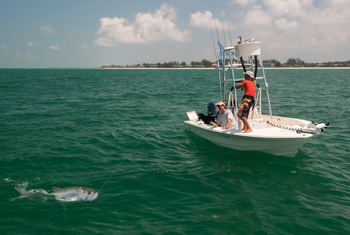Get into fishing: Back to basics

RUSTY CHINNIS | submitted
Good angling basics are often passed from fathers and
mothers to sons and daughters. Here, Benny Parrish
coaches his son, Hunter, as he lands a tarpon off Longboat Key.
Sport fishing writers usually like to recount the exploits of seasoned anglers or delve into some specific type of fishing like fly rodding for tarpon. However periodically it’s important to get back to the basics, the foundations that all good fishing is built on. This is a way to reach out to people who want to learn to fish, those who are new to fishing and also as a way to remind every angler that fishing doesn’t have to be complicated.
Fishing means different things to different people. To some it’s the simple pleasure of being on the water, where catching is optional. To others it’s serious business and the outcome can make or break a day on the water. For others it’s the search for a meal or just an opportunity to share time with friends or family. Whatever fishing means to you, it doesn’t have to be complicated. If fact, I’m convinced that the less complicated it is the better your chance of success. That might not be apparent when browsing the tackle department at your nearest sporting goods store or tackle shop. There is a plethora of gear lining the shelves meant to dazzle and lure anglers. Even the basics like line and hooks come in many shapes and colors, each promising the angler an advantage over the fish. Lures dazzle the eye with a rainbow of colors in mind-bending holographic patterns. In truth experience has taught me that there’s no special magic to finding the right gear for angling success. Instead, concentrating on a few basic time-tested techniques will improve the luck of even the greenest angler.
Most important is the essential outfit: rod, reel and line. Pick the best quality tackle you can afford, but not the most expensive available. I’m talking about gear that is solidly made, able to survive the rigors of saltwater. Whether you’re using spinning tackle, fly tackle or bait casting gear, get an outfit that’s balanced and appropriate for the kind of fishing you’ll be doing. A balanced outfit means that the weight is evenly distributed when held just forward of the reel on the cork of the rod. This isn’t an exact science, but you’ll be able to feel if one component is too large.
An appropriate outfit is one that is up to the task of catching the fish you’re targeting, but no heavier than necessary. An 8- to 10-pound rig is perfect for snook, trout, redfish and other inshore species while a 20- to 40-pound outfit would be better for anglers hunting kingfish and cobia along the beach or bottom fishing for grouper, snapper or amberjack over offshore ledges and wrecks. The line should also match the outfit you’re using and should fill the spool of the reel. The most common problem I see is reels with too little line that’s too heavy. This severely hampers the angler’s casting ability.
When it comes to deciding whether to use live bait or artificial lures I think artificial lures are a better choice especially for beginning anglers. First and foremost they are a lot easier to deal with than live bait. Live bait takes time to acquire, must be kept healthy and usually stays close to where it’s cast. Artificial lures by contrast don’t have to be changed often and can’t be killed or crippled by pests like pinfish. You can cover more water, testing different areas, water depths and retrieval speeds. My personal favorite is a jig, and while I now use mostly lead headed jigs with plastic bodies, the original lead head jigs with bucktail skirts are still a great choice. My second choice would be a top water plug. These lures require a bit of practice to master but are recommended because they cover a lot of water, and they attract fish with their sound and surface disturbance.
Consult with your local tackle shop when choosing an outfit. They know the area, have a wealth of experience and can be trusted to get you off to a good start. While big box stores might seem a good place to shop, you’re not as likely to get the professional advice of a local shop. I would suggest doing some homework before going shopping. In my next article I’ll discuss where to find fish and some of the techniques that will improve your odds at getting them to bite.

